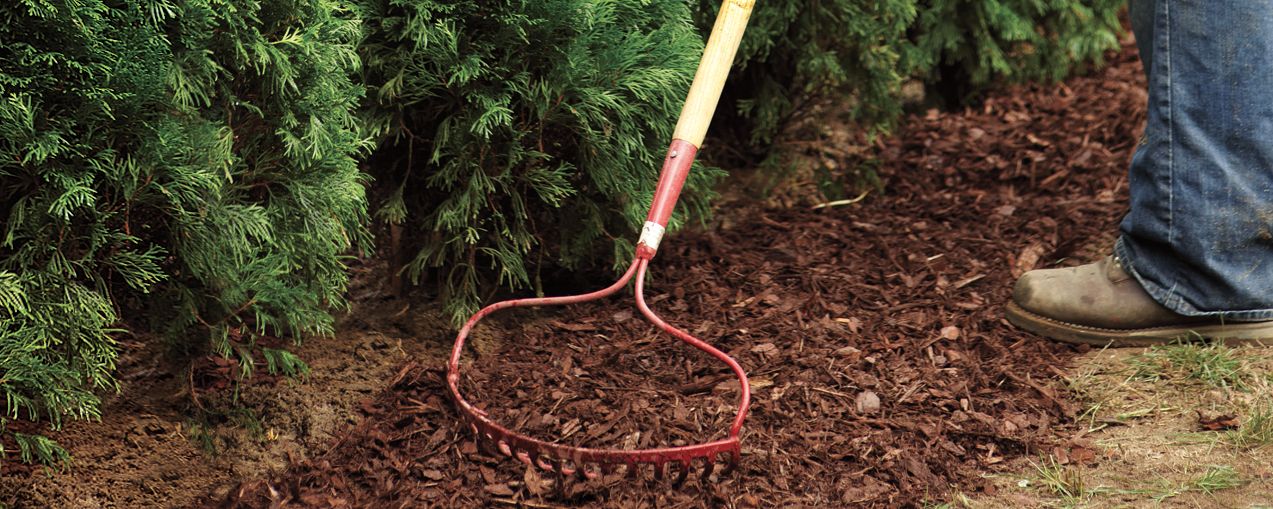We may be compensated if you purchase through links on our website. Our team is committed to delivering honest, objective, and independent reviews on home products and services.
Creating a natural barrier around your property can enhance privacy, reduce noise, and add allure to your landscape. Planting a privacy hedge is an excellent way to achieve these benefits while improving your home’s curb appeal. This guide will walk you through the process of planning, planting, and maintaining a privacy hedge, to help you create a lush, green screen.
Benefits of Privacy Hedges
Privacy hedges serve multiple purposes in your landscape, such as:
- Visual barrier: They block unwanted views and create a secluded outdoor space.
- Noise reduction: Dense foliage can help muffle sounds from nearby streets or neighbors.
- Wind protection: Hedges can act as windbreaks, sheltering your property from strong gusts.
- Wildlife habitat: Many hedge plants provide food and shelter for birds and small animals.
- Air purification: Like all plants, hedges absorb carbon dioxide and release oxygen, improving air quality.
Popular Plants for Privacy Hedges
Several plant species are well-suited for creating privacy hedges, including:
- Arborvitae (Thuja occidentalis): Known for its dense, evergreen foliage and adaptability to various climates, this evergreen will provide privacy year-round.
- Privet (Ligustrum): Fast-growing and easy to shape, privet hedges are a classic choice for privacy screens.
- Boxwood (Buxus): Slow-growing but extremely dense, boxwoods are ideal for formal hedges.
- Leyland Cypress: Fast-growing evergreens that can quickly create tall privacy screens.
- Bamboo: For a tropical look, bamboo provides quick growth and dense coverage. Make sure to choose a “clumping” variety rather than a “running” variety, as the latter can be very invasive.
Planning Your Privacy Hedge
Before planting a privacy hedge, consider factors such as location, climate, and plant selection to ensure your hedge thrives and meets your needs.
Determining the Right Location
When choosing a location for your privacy hedge, consider factors such as:
- Property lines: Ensure you’re planting within your property boundaries.
- Sunlight: Most hedge plants require full sun to partial shade.
- Soil conditions: Test your soil to determine if amendments are needed.
- Utilities: Avoid planting over underground utilities or near power lines.
- Mature size: Account for the full-grown width and height of your chosen plants.
Choosing the Best Plants for Your Climate
You should also select plants that are well-suited to your local climate and growing conditions. Be sure to choose plants that can withstand your area’s winter temperatures. In dry climates, opt for plants that require less water.
You should also consider growth rate, and how quickly you need to have privacy when choosing a species, as some will take longer to provide full coverage. Finally, keep maintenance in mind, as some plants require more pruning and care than others.
Essential Tools and Materials for Planting
Here’s what you’ll need for your hedge-planting project:
Digging and Planting Tools
- Spade shovel for digging the trench
- Garden fork for loosening soil
- Cultivator for teasing roots from the root ball
- Tape measure for proper spacing
- Pruning shears for root trimming
- Wheelbarrow for moving soil and plants
- String and stakes or spray paint to mark the area
Soil Amendments and Mulch
- Compost or well-rotted manure
- Peat moss for acidic soil-loving plants
- Slow-release fertilizer
- Mulch
Steps for Planting a Privacy Hedge
Step 1: Dig a Trench
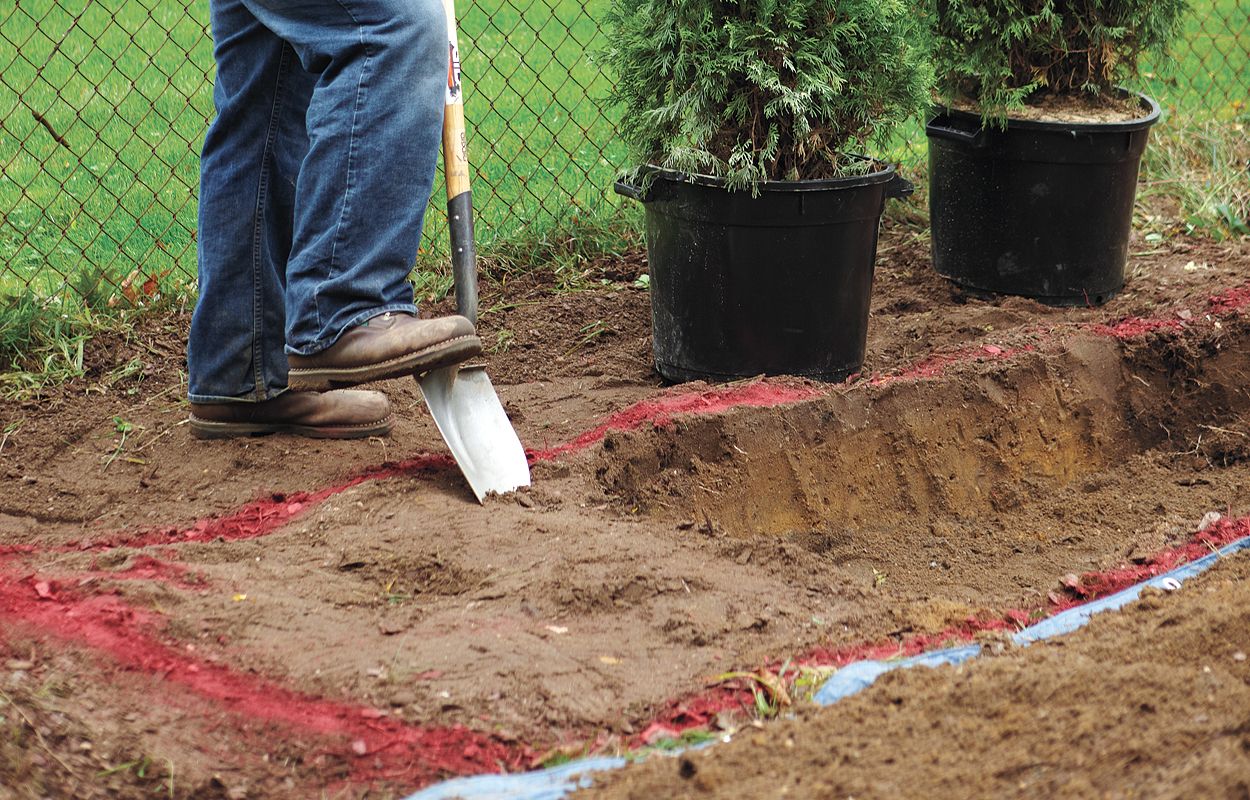
Measure the height and width of the largest root ball. Then use spray paint to mark out a trench that is two to three times wider and two inches shallower than the root ball.
Make the trench long enough to space the trees so that they will touch when they reach their mature width—three to four feet apart for these Emerald Greens. As you dig, transfer the soil with a spade shovel onto a tarp. Loosen the soil at the bottom of the trench with a garden fork.
Step 2: Roll the Tree into the Trench
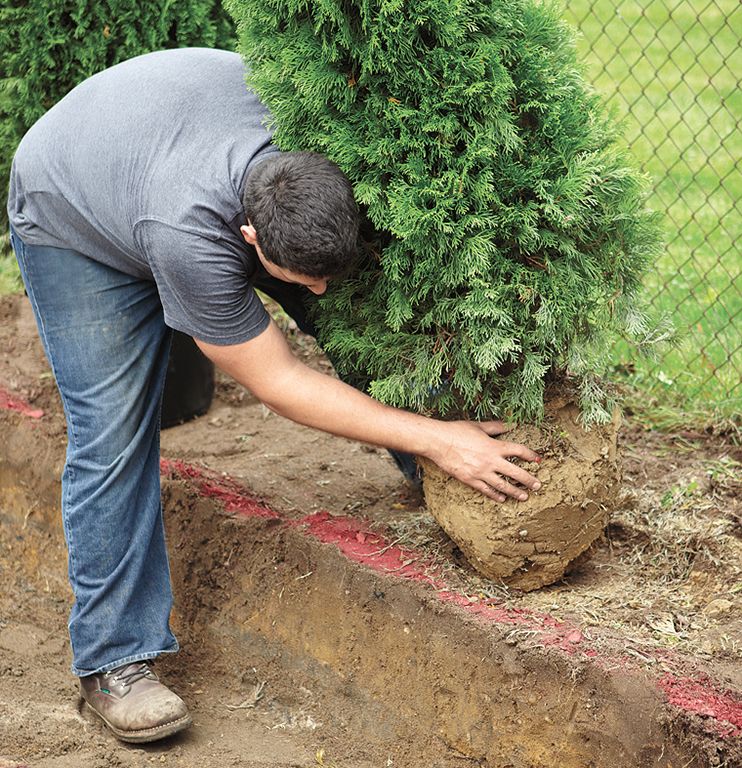
Lay a container-grown tree on its side and remove the tub. Then stand the tree up and gently roll its root ball into the trench. (For a burlapped root ball, roll it into the trench, then cut away as much fabric as possible.)
Turn each tree’s best side to face your yard. Measure from trunk to trunk to set the spacing and from the trench edge to each trunk to align them.
Step 3: Tease out the Roots
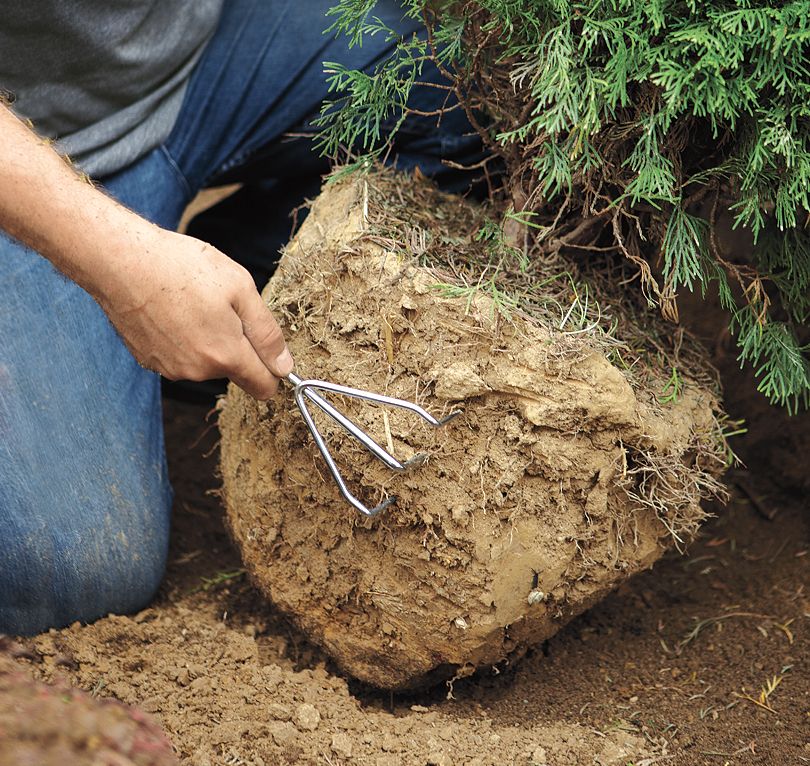
With a cultivator, gently scrape across the sides, top, and bottom of each root ball to expose the tiny roots that absorb water and fertilizer.
In a wheelbarrow, mix two parts excavated soil with one part compost, then backfill the trench up to grade. Form a soil dam around each tree just wider than the diameter of the root ball.
Step 4: Soak the Soil
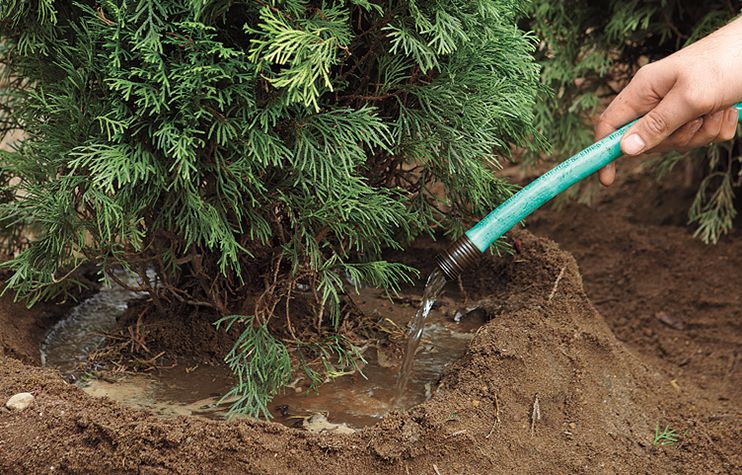
Fill each dam with water, wait for it to be absorbed, then fill again. When the water soaks in the second time, rake away the dam and add a two- to three-inch layer of mulch. Keep it away from the trunks to prevent rot.
Caring for Your Newly Planted Hedge
The first few months after planting are critical for establishing a healthy privacy hedge. Proper watering and care during this period will set the foundation for robust growth.
Watering Schedule
Consistent moisture is crucial for new plants:
- Water deeply once a week, unless there’s significant rainfall.
- For sandy soils, water if there’s no rain for two weeks.
- In clay soils, water if there’s no rain for four weeks.
- Adjust watering based on weather conditions and soil moisture.
Fertilizing and Mulching
Once a year, typically in the spring, apply a slow-release fertilizer according to package instructions. Once or twice a year, in the spring or fall, you’ll also want to replenish mulch to maintain moisture and suppress weeds.
Maintaining Your Privacy Hedge
Regular maintenance keeps your hedge healthy, dense, and shaped to your liking.
Pruning Techniques
Pruning is essential for maintaining hedge shape and density. Begin light pruning in the first year to encourage bushy growth. Trim the top and sides annually to maintain desired height and width. Use hand pruners for precision cuts on individual branches, and prune in later winter or early spring before new growth begins.
Dealing with Pests and Diseases
Monitor your hedge regularly for signs of trouble:
- Inspect leaves for discoloration, spots, or insect damage.
- Look for any dieback or thinning areas in the hedge.
- Treat pest issues promptly with appropriate organic or chemical controls.
- Improve air circulation by thinning dense areas if fungal diseases occur.
Timeline for Privacy Hedge Growth
Understanding the growth timeline helps set realistic expectations for your privacy hedge. While some plants grow quickly, others take time to fill in and reach their full potential.
First Year Care
The care you give in the initial growing season will affect how well your plants do in subsequent years. Focus on establishing strong root systems through consistent watering. Avoid heavy pruning, allowing plants to acclimate to their new environment and monitor for any signs of stress or disease, addressing issues promptly.
Long-Term Development
Patience is key as your hedge matures. Expect noticeable growth and filling in by the second or third year. Most hedges reach their full privacy potential within three to five years. Continue regular maintenance to ensure long-term health and appearance.
Extending the Lifespan of Your Hedge
To ensure your hedge remains robust and attractive, follow these tips:
- Conduct regular inspections: Periodically check for any signs of damage, disease, or pest infestations, and address them promptly.
- Check soil health: Conduct soil tests every few years to monitor pH levels and nutrient content, making amendments as necessary.
- Provide seasonal care: Adjust your hedge care routine based on seasonal changes, such as watering extra during dry spells and mulching before winter to protect roots.
